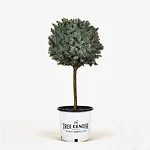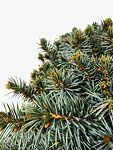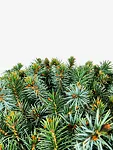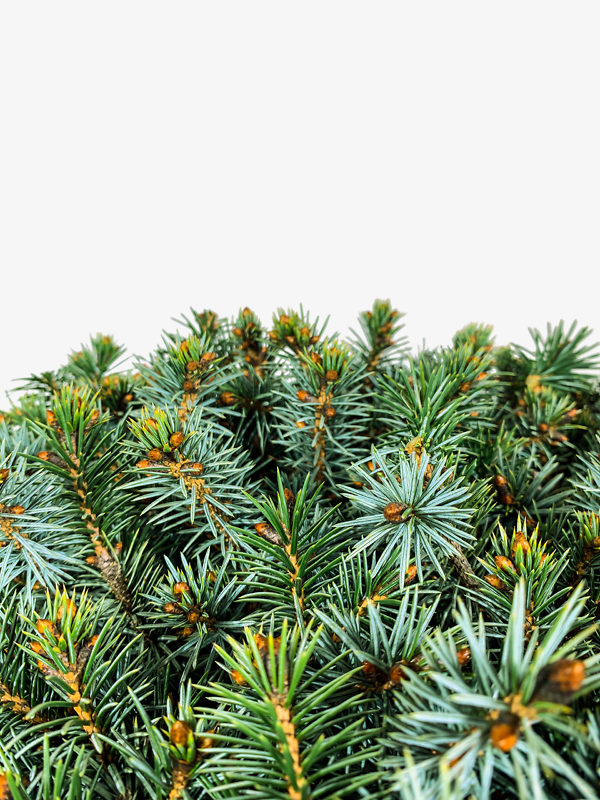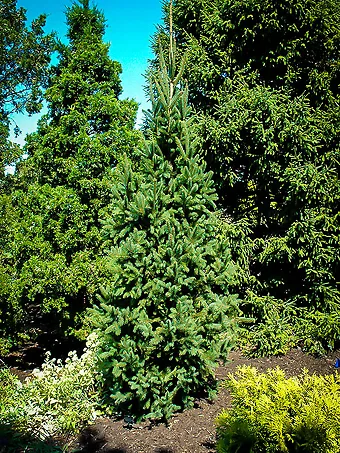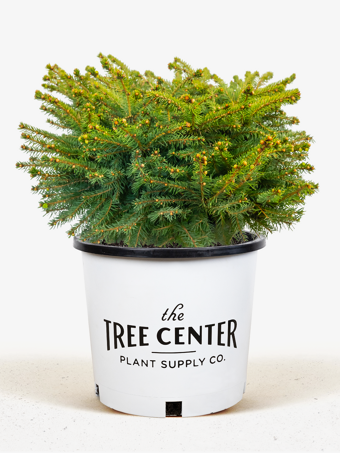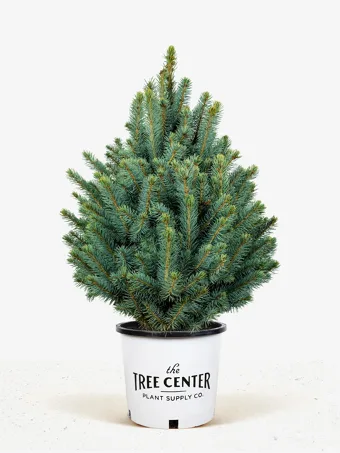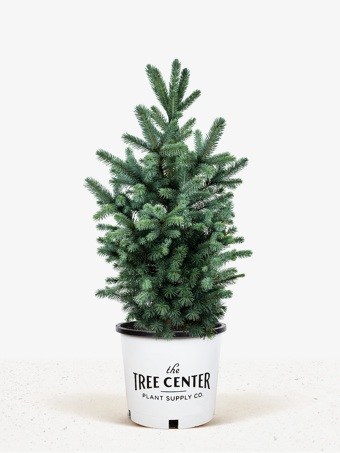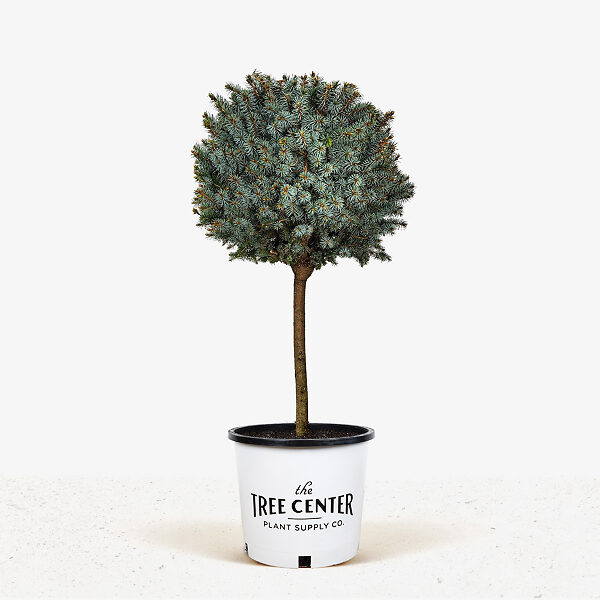
Dwarf Papoose Sitka Spruce Tree Form
Picea sitchensis ‘Papoose’ (= ‘Trinket’)View more from Spruce Trees
Dwarf Papoose Sitka Spruce Tree Form
Picea sitchensis ‘Papoose’ (= ‘Trinket’)
30 day - ARRIVE AND THRIVE™ guaranteeLearn more


Special Features

Botanical Name
Picea sitchensis ‘Papoose’ (= ‘Trinket’)
Outdoor Growing zone
6-8
Mature Height
4-5
Mature Width
2-4
Sun needs
Full Sun
The Papoose Sitka Spruce is a wonderful globe of tightly-packed stems, covered in short, silver-blue needles. It grows slowly, so it has been attached to a short trunk to lift it of the ground and form a miniature tree, which shows it off so much better in your garden or in a pot, while it is still young. In time it will become a globe, measuring 3 to 5 feet across. Use it in containers as a specimen, as an accent in a small garden bed, or as part of a collection of dwarf and unique evergreens. This gorgeous little plant will win your heart and ask nothing special in return. When you consider that the parent tree can be 250 feet tall, this miniature beauty is a natural miracle.
- Perfect globe of silver-blue foliage on a short trunk
- Great small accent plant for small places, and in pots
- Never needs clipping to always look perfect
- Grows well in moist, well-drained soil
- Slow-growing, very neat and attractive
Grow the Papoose Sitka Spruce in any moist, well-drained soil. When well-established it has reasonable drought tolerance, but it grows best with a regular supply of water, and in mild climates that are not too hot or too cold. It is a great choice for coastal areas, and it has no significant pests or diseases. Absolutely no trimming in needed to keep it looking perfect, neat and round forever.
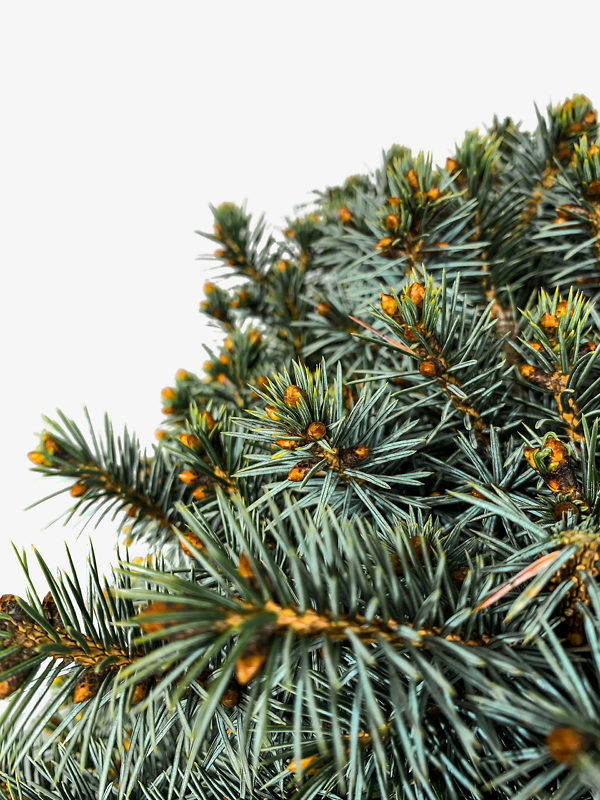
There is something wonderful about dwarf plants, especially when they are perfect in all their parts, with a neat, dense form, and giant charm in their dwarf stature. A problem with growing them is that they are ground-hugging when young, and so they are not very showy until they have reached a good size. A great solution to this is to mount them on a sort trunk, so that they are taller, while keeping their unique miniature character. This way you can admire them from an early age more effectively. You can watch them develop, becoming more and more charming with each passing year of new growth.
The Papoose Sitka Spruce is exactly one of those perfect dwarf forms, growing into an almost perfect spherical mound of densely packed branches, each one wrapped in short, stiff silvery-blue needles. It grows slowly, adding 4 to 6 inches a year, so we have had expert growers mount this plant on a strong stem created from a seedling spruce. This lifts it into the air and adds 12 inches to its height, so that you can enjoy its perfect charms right from the beginning, and watch it develop into a superb specimen, gradually becoming a ball 3 or 4 feet across in time, and a height of 4 to 5 feet, including the trunk.
Growing Dwarf Papoose Sitka Spruce Trees
The Papoose Sitka Spruce can be used in many ways around the garden. Plant it among low-growing shrubs and perennial plants as an accent, and to bring its blue color to your planting scheme. Grow a pair in pots on either side of a doorway, an entrance, or even a bench. Use it as a permanent specimen in planter boxes, where the clean trunk makes it easy to plant flowers beneath it, and the bush gives winter interest.
A great way to create a garden feature is to collect different types of dwarf evergreens – you will find an extensive collection on our site – and plant them in a display bed. Choose a mixture of shapes – flat, round or exclamation marks – and colors – green, blue, silver and gold – and mix them together in a bed among rocks and boulders. Finish it off with a layer of gravel or pebbles, and you have an enduring feature that requires no maintenance, but that becomes better and better every year. Allow plenty of room, at least the 10-year size we usually list, and ideally a bit more, as these plants may start small, but many grow surprisingly large over time.
Appearance
The Papoose Sitka Spruce forms a round ball of many branches, with a smooth shape that you might think had to be maintained by clipping. It doesn’t, and the effect is completely natural. When old it may slowly develop a more conical shape, but most plants remain spheres for years and years. The short needles are packed tightly around the stems, and they are bright, silvery-blue on the upper surface, and blue-green on the lower surface, creating an attractive contrast, and a more textured blue effect to the whole plant. New growth in spring is soft and greener, with the needles turning stiffer and bluer as they mature.
Planting and Initial Care
The Papoose Sitka Spruce should be planted in full sun, in well-drained soil. It does not grow well in highly alkaline soils. It is not particularly drought-tolerant, and prefers moisture, but established plants will easily tolerate normal summer dry periods. It grows best in areas with moderate climates, rather than regions with long, intense summer heat, or severe winters. It has no significant pests or diseases, and it is very easy to grow.
History and Origins of the Dwarf Papoose Sitka Spruce
The Sitka spruce (Picea sitchensis) grows naturally along the northwest coast of North America from Kodiak Island, Alaska to Mendocino County, California. It is almost always found at high altitude, but close to the sea, and never more than 125 miles from it. It grows into a towering tree, with a single, straight trunk that can be 250 feet tall, and 17 feet wide at the base, in old specimens. Like many other conifers it can develop what are called ‘Witches’ Brooms’. These are usually dense clusters of tiny branches, caused by mutations.
Gordon Bentham, who worked in a supermarket on Vancouver Island, was a keen hiker and enthusiastic conifer expert. In 1964 he found a Witches’ Broom on a wild Sitka Spruce on that island, grew roots on it, and called it ‘Papoose’. He gave it to the Parks Department of Victoria, B.C. who later released it to nursery growers. Our growers have taken this wonderful little plant and attached pieces to sturdy stems of seedling Sitka spruce, turning them into a single plant. There is always a huge demand for the best forms of dwarf conifers, which this certainly is, so our stock will soon be gone. Order now.
